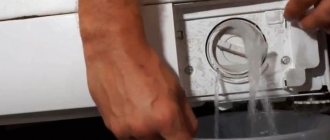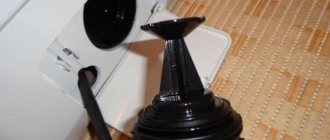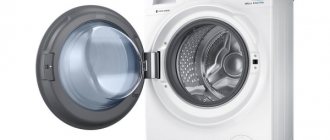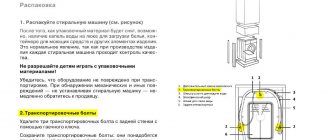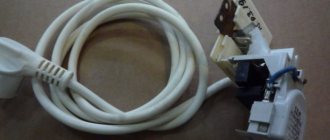Where is the pump and pump located?
Each of the models of automatic washing machines has its own structural layout of components. Some expensive units consist of two types of pumps: a circulation pump and a drain pump. The circulation pump supplies water directly to the washing area, and the drain pump removes it from the machine tank. The area where the circulation pump should be located coincides with the location of the drain. On the modern domestic market, models with one drain pump are mainly presented. Washing machines with two pumps are very rare to see.
Removal of the drain pump, depending on the structural layout, can be done through the bottom, rear or front parts of the washing machines.
How to detect the problem
Although regular cleaning should be done, many washing machine owners forget about it. In this situation, a blockage occurs that will prevent the machine from continuing to operate.
Modern washing machines, such as Indesit or Atlant, are equipped with a built-in diagnostic system that can determine the cause of the failure:
- If the pump is clogged, it may indicate that the problem is in the drain system. This problem is visually manifested in the fact that water stops flowing from the tank.
- It is possible that drainage occurs, but very slowly and unevenly. In this case, the water will not flow out completely. As a result, the diagnostic system stops the car. In this case, you can hear the noise that is made during operation. Sometimes knocking sounds are heard if foreign objects get there.
When the diagnostic system indicates improper operation of the drain system, the instructions indicate the need for cleaning. To do this, you need to disconnect it from the washing machine.
Signs of blockages
You can identify the presence of a blockage in the drain filter by the following signs:
- The machine does not turn on and gives an error. The error code can be anything, but it is important to make sure that the device is correctly connected to the water supply and electrical network, and that the drain hose is located at the correct angle;
- the time for draining water increases due to its prolonged removal from the drum or at the end of the cycle the laundry remains wet, and a small amount of liquid is present inside the tank;
- The “Spin” or “Rinse” functions do not work.
When and how often should you check the condition of the filter?
It is urgently necessary to clean or replace the part when:
- rinsing is disrupted;
- water fills/drains slowly or does not happen at all;
- The washing mode stops and an error appears on the screen;
- washing powder remains in the compartment;
- the time of the modes increases;
- there is an unpleasant odor coming from the equipment;
- Spin does not start.
You need to wait until the machine stops and inspect the filter elements. If necessary, they are cleaned and components are replaced.
Instructions for checking functionality
Signs of abnormal operation can be seen by listening to the sound the pump makes. It should be smooth, without noticeable sound deviations. Before you clean the pump in the washing machine and test it for functionality at home, you need to remove it.
First of all, you need to remove the drain filter located at the bottom of the front panel under a small hatch. It opens after pressing the latches. The filter is unscrewed by thread. Do everything carefully so as not to break the parts. Do not forget that you will have to drain the remaining water from the drainage system.
After disassembling the elements of the machine body that limited access to the pump, the drain pump itself is removed. After a detailed inspection, the drain pump (by unscrewing the mounting screws) is disconnected from the volute. Then the following steps are performed:
- external control is carried out for the presence of mechanical damage;
- check for traces of washed clothes, such as hair or lint, on the impeller;
- by manually rotating the rotor, the engagement of the impeller with the rotor shaft is determined;
- The play of the rotor shaft in the mounting slots and the amount of wear are checked.
The electrical part of the pump is diagnosed using a multimeter or tester, so the problem can be determined. The device is set to the dialing mode, and the control wires are connected to the metal contacts of the pump. Any three-digit number on the instrument scale means normal. Values “0” or “1” indicate an open circuit.
The serviceability of the electrical part can be checked by connecting special contacts from the network to the pump. In this way, tests are carried out to identify the problem and find out whether the pump operates when power is applied to the motor. Analysis of faults allows us to draw a conclusion about the possibility of repairing or replacing the drain pump.
What to do when the filter does not unscrew or cannot be pulled out
Sometimes cleaning the washing machine pump filter is difficult because it is impossible to get it out of the machine:
- you try to turn the handle to no avail;
- or the filter is stuck in the hole and cannot be pulled out.
Such situations occur if the drainage unit has not been cleaned for a long time.
The filter may not unscrew for two reasons. Firstly, a foreign object (for example, a piece of bra wire) can prevent rotation, and secondly, scale formed on the threads and gasket.
Most often, pulling out the filter is prevented by a foreign object stuck across it or a lint ball of debris inside.
If you find yourself in this situation, you can act in two ways:
- Use pliers if the filter does not unscrew. Try using them to turn the filter knob. Do this very carefully, without fanaticism, so as not to break the part.
- Clean the filter through the removed pump if the pliers did not help to unscrew it or the filter cannot be pulled out. Depending on the make and model of the machine, you will need to remove the back or front wall of the machine body, disconnect the wiring, remove the clamps that secure the drain pipe and hose to the pump volute, and pull out the pump itself with the volute. Next, it is most convenient to clean the filter through the hole for the drain pipe. Or disconnect the pump from the volute (it is secured with screws or latches) and clean the filter through the pump hole. After this, it should easily unscrew and pull out.
Attention! The described method of cleaning the filter through the drain pump requires knowledge about the structure of the washing machine, and is therefore difficult for average users. If you are not sure that you can handle this operation yourself, then call a specialist, for example, from our RemBytTech service.
For those who nevertheless decided to deal with the stuck unit on their own, we recommend the article “How to get the drain filter if it cannot be unscrewed.”
What happens if you don't clean it?
A blockage in the trap creates serious problems for the normal functioning of the device; failure to clean it will aggravate the situation:
- the appearance of an unpleasant odor in the washed laundry or emanating from the drum. Pathogenic bacteria actively develop in the accumulated garbage, causing this lump of dirt to smell bad. Gradually, mold and mildew form there. By the way, citric acid can also help get rid of the smell in the washing machine; more details in this article;
- problems with drainage. The extreme stage of this situation will be the complete impossibility of removing dirty water from the drum or the washing machine refusing to start the wash cycle;
- complete failure of the drain pump. In this case, there is an increased likelihood that large debris will jump over the clogged filter and jam the pump or break the impeller blades. Only complete replacement of the part will help correct the situation. A repairman will be able to carry out this operation, which entails additional financial costs.
Maintenance frequency
Standard recommendations suggest cleaning the washing machine filter once every 2-4 months, depending on the intensity of its use.
If the device is used several times daily, the drain pump mesh should be cleaned every month or more often.
Also, the frequency of maintenance of this part depends on the type of fabrics that are most often washed. For example, if you frequently load flannel, flannel, or woolen items into the tank, it is recommended to clean the filter once every few weeks.
If a down jacket or feather pillow has been washed, then it is necessary to remove dirt from the filter immediately after the end of the cycle. If you find a missing part on clothing after washing (a bra wire or a button), you should immediately check the drain filter mesh.
Why can’t I unscrew, remove and remove the filter?
The main reason is foreign objects. Lint, wool, hair, small foreign bodies, handkerchiefs, napkins, socks fall into the trap in front of the pump and tightly block its movement in the cochlea.
More rarely, removing the washing machine filter is made difficult by scale deposits on the threads. It forms if it has not been cleaned for a long time.
We recommend! Once every 2-4 months, clean the filter from debris and foreign objects. Detailed instructions are in the article “How to clean the filter in a washing machine.”
Step-by-step instruction
Unscrewing a soured washing machine filter is sometimes very difficult. It is necessary to act carefully, not to apply too much force, so as not to break the machine parts.
In addition, you need to make sure that the rotation is in the right direction - counterclockwise. To resolve the issue, you can use several methods.
Using a tool
One of the easiest options is to try to grab the filter handle with pliers and unscrew it. Caution is required here, as the force is quite large. Without proper calculation, you can break the handle of the knot. You need to act slowly, rocking, turning the plug in both directions and gradually increasing the amplitude.
If the filter can be turned a quarter turn but does not go any further, do not apply force. It's better to try another way.
Removing the drain pump
If you cannot unscrew the cover using the usual method, you can try dismantling the entire pump. As a rule, it is attached to the machine body with two screws, but there are a lot of manufacturers, so any options are possible.
Types of filters and their purpose
The drainage (inlet) element is designed to prevent large and fibrous objects from entering the drain pump wheel blades. It is installed inside the device on the path of dirty water moving to the drain electric pump. It looks like a glass-shaped plastic stopper with holes .
The drain filter of the washing machine is located at the bottom of its front wall under the filling hole . The part is hidden under a small hinged lid, which can be round or rectangular. The manufacturer can also place it under a removable panel, which occupies the entire width of the case at the very bottom.
Step-by-step cleaning instructions
Proper maintenance will extend the life of your washing machine. And the risk of a situation where at the most inopportune moment some element breaks is reduced. And dirt accumulated in various components can lead to failure of one of them. Therefore, it is important to carry out preventive maintenance of all elements of the machine that are subject to contamination during operation.
Cleaning the drum and heating element of the washing machine from scale
Various impurities of hard tap water create conditions for the formation of deposits on the drum and heating elements of the washing machine. Scale from calcium and magnesium salts can be removed by washing in a solution of citric acid.
If the amount of deposits has reached a significant size, then the heating element should be removed from the machine. Cleaning as part of all equipment leads to breakdown of the drain pump or other components.
Cleaning the rubber seal
After you finish washing all components and parts in a solution of citric acid, the work is not finished yet. There are places covered with sealing rubber where mold accumulates. Using a damp cloth and cleaning product, thoroughly wipe the area behind the pulled elastic. Finish the process by wiping with a dry cloth.
Cleaning the tray (bath, dispenser)
For high-quality cleaning, the container for powder, softener and other products must be removed from the washing machine. Different models have their own method, which is indicated in the instructions for use. The compartment in which the tray should be located can be cleaned with special products, using small brushes for hard-to-reach places. Soak the tray itself for 30 minutes in a solution of household chemicals or a mixture of vinegar and soda. After this procedure, the plaque will easily come off with a sponge.
Cleaning the filler filter
In order to clean the inlet filter from dirt and foreign objects, it must be carefully pulled out, preferably with pliers. You should pull it out without tugging, since the part is fragile and in case of breakage cannot be repaired, but only replaced. Rinse the filter mesh with warm water and scrape off the accumulated dirt and plaque by hand or with an old toothbrush.
If after washing the mesh does not show through to the light, then it’s time to change it, or try soaking it in a descaling solution and cleaning it again. After washing, the filter is installed in the mounting hole and checked for leaks during the first wash.
Can't unscrew
Sometimes it is not possible to unscrew and remove the filter due to various objects stuck in it. Hair, socks and handkerchiefs, coins, beads and other small items during washing can end up in the catcher in front of the pump and plug it. Limescale deposits on the threads, which occur if the filter has not been removed for a long time, can also become an obstacle.
In this case, there are three ways to open the garbage filter. Apply them in turn, proceeding to the next method only if you tried the previous one and it did not help. Before you begin, be sure to unplug the machine and close the valve to prevent water from flowing.
- 1 way . Use pliers or pliers to unscrew the filter cap. There is a handle on it that you need to try to turn using a tool. Manipulations should be carried out very carefully so as not to break the filter part.
- Method 2 . Lightly tap the drain pump filter cover several times while tilting the washing machine.
This method is suitable when:
- The garbage filter cover does not rotate at all;
- partially rotates;
- It can be unscrewed, but it cannot be removed.
Tilt the machine back and lean it against the wall. Tap the dust filter cover and the housing next to it. If the snag is in small objects that have stopped the desired part, then the knock will cause them to move, and you can unscrew and pull out the filter.
3 way . If the previous two methods were unsuccessful, then you need to completely remove the drain pump. The task is to clean the snail and remove the filter. This method is quite complicated - you need to get to the pump, unhook the pump from the volute and through the resulting hole get to the filter.
The design features of certain models of Kandy washing machines allow the drainage pump to be dismantled through the bottom. If it is easily removed or is absent altogether, then it is easier and more convenient to get the snail with the pump in this way. Putting the machine on its side or simply tilting it in the desired direction and resting it on the wall, remove the bottom and find the pump. It is located behind the filter, that is, in the lower part of the housing.
The listed methods should only be used if you are confident in your abilities and have certain skills in repairing various devices. If the filter does not unscrew and you are not very well versed in technology, it is better to call a specialist. It must be remembered that through ignorance you can not only waste time, but also worsen the situation.
What to do when the filter does not unscrew or cannot be pulled out
Sometimes cleaning the washing machine pump filter is difficult because it is impossible to get it out of the machine:
- you try to turn the handle to no avail;
- or the filter is stuck in the hole and cannot be pulled out.
Such situations occur if the drainage unit has not been cleaned for a long time.
The filter may not unscrew for two reasons. Firstly, a foreign object (for example, a piece of bra wire) can prevent rotation, and secondly, scale formed on the threads and gasket.
Most often, pulling out the filter is prevented by a foreign object stuck across it or a lint ball of debris inside.
If you find yourself in this situation, you can act in two ways:
- Use pliers if the filter does not unscrew. Try using them to turn the filter knob. Do this very carefully, without fanaticism, so as not to break the part.
- Clean the filter through the removed pump if the pliers did not help to unscrew it or the filter cannot be pulled out. Depending on the make and model of the machine, you will need to remove the back or front wall of the machine body, disconnect the wiring, remove the clamps that secure the drain pipe and hose to the pump volute, and pull out the pump itself with the volute. Next, it is most convenient to clean the filter through the hole for the drain pipe. Or disconnect the pump from the volute (it is secured with screws or latches) and clean the filter through the pump hole. After this, it should easily unscrew and pull out.
Attention! The described method of cleaning the filter through the drain pump requires knowledge about the structure of the washing machine, and is therefore difficult for average users. If you are not sure that you can handle this operation yourself, then call a specialist, for example, from our RemBytTech service.
For those who nevertheless decided to deal with the stuck unit on their own, we recommend the article “How to get the drain filter if it cannot be unscrewed.”
What to do if the filter leaks after cleaning
After removing contaminants, the filter may leak. It is not possible to identify this problem immediately, but after 2-3 washing cycles. The reasons for the appearance of water can be:
- Incorrect installation of the part. The filter may not be inserted straight into the hole or may not be screwed in completely. It is necessary to fix the part in exact coincidence with the thread, and tighten it more tightly until it stops, but without using excessive force;
- wear of the rubber gasket. Over time, this part, which ensures tight contact between the filter and the socket, can dry out or become damaged if dismantled carelessly. To eliminate the leak, you will need to install a new original gasket or replace the entire assembly if there is no replacement for it;
- thread damage. Such mechanical failure can occur if the part is incorrectly unscrewed or if force is used to remove it. The problem can be corrected only by completely replacing the damaged unit. In some cases, it may be necessary to install a new “snail”. This work must be performed by a certified repair technician.
Other reasons for slow drainage
A clog at the filter level is a common, but not the only reason for slow or non-existent drainage. Quite often it is caused by a malfunction of the pump (pump), problems with the pressure switch (water level sensor) or malfunctions of the control module. Sometimes it happens that water is drained on some programs, but not on others. In this case, the mechanical components of the device are working properly; the problem should be looked for in the electronics.
Drain pump failure
The pump is responsible for pumping dirty water from the tank through a system of pipes and hoses directly into the sewer. The pump is usually installed at the bottom of the machine, under the tank. This arrangement allows the device to optimally perform its function. Over time, the pump, like the drain filter, may become clogged, and then the water will drain very slowly.
When metal objects (keys, coins, buttons) enter the drain system, they often break the impeller blades or damage the pump body. A complete lack of drainage most often indicates a violation of the integrity of the pump or combustion of the motor as a result of voltage surges.
Electronics malfunction
This breakdown is somewhat less common than the ones listed above. However, it is this that is the most difficult and expensive to eliminate. All processes in the machine are controlled by an electronic module; it is this module that activates the pump. At the right moment, a command is given to turn on the pump, and when all the liquid is pumped out of the tank, a signal to turn off is given. If the wiring or triac of the pump burns out, the connection between the nodes is interrupted, and water will not be drained, even if the pump is working.
Such repairs are not cheap, because the repairs are carried out by highly specialized electronics specialists. But they, as a rule, give a guarantee on their work for a month or two. After this period, the problem may return. In addition, it is not always possible to restore a damaged control unit, and replacing it is impractical due to the high cost of the spare part itself. Therefore, if you have such problems with electronics, you should seriously think about buying a new washing machine.
How to open the filter cover in a washing machine?
Foreign objects in pockets, small debris, hair and threads do not disappear without a trace after loading things into the drum. All this passes through the drain filter, pump and, in the best case, goes into the sewer. It also happens that debris clogs the parts and blocks the pump. The problem is accompanied by the following symptoms:
- the machine does not completely drain the water;
- operation stops and an error code appears on the display;
- Water leaves the tank slowly and intermittently, while the pump’s hum and crackling noise can be heard.
Ideally, the filter should be cleaned once a month. If the user follows the instructions, then no problems arise - the element is easy and simple to get. Just open the panel:
- In the Samsung, LG, Zanussi, Kandy, and Atlant washing machines, the filter is hidden behind a small door under the loading hatch. Press the door with your hand or pry it with a screwdriver to gain access to the part.
- In Bosch machines, the element is hidden by a long decorative panel at the bottom. In earlier models, the lid is attached to hooks. Install them horizontally using a screwdriver and remove the panel. In the latest models, the latches are pressed with a slotted screwdriver, and the door is moved to the side.
- In SMA "Ariston", "Indesit" there is also a solid panel. Immediately press the lower, then the upper latches and remove the filter.
Important! Some washing machines (especially the vertical type) do not have a drain filter. Here the pump, pipes and hoses are cleaned.
Now you can move on to cleaning the elements. But here, too, problems occur. The next section will help you solve them.
Alternative ways to solve the problem
It is not always possible to remove a stuck drain filter even after removing the pump. In such cases, the main reason lies in a thick layer of scale or sodium deposits due to hard water. Removing them is much more difficult than removing debris and dirt.
But this is not a reason to buy a new washing machine. There are several alternative methods that will be much cheaper.
- Dissolve the lime. It is best to get rid of scale using citric acid. To do this, put 1-2 spoons of lemon juice into the drum and start a short cycle at a water temperature of 40-60 degrees. If by that time the pump has already been disassembled, then we soak the glass with the filter in the same solution in the proportion of 1 tablespoon per six-liter basin. Do not forget that the water should not be higher than 60 degrees, otherwise the rubber seal will be seriously damaged. It doesn’t hurt to weigh down the parts so that the plastic case does not float to the surface for 1-2 hours. As soon as the time is up, take it out, rinse it under cold water and try to free the catcher from the snail using any of the methods described above.
- Break out the filter. If the citric acid trick doesn't work, you'll have to act more harshly. We take pliers or wire cutters and carefully break off the fragile plastic of the catcher body. Then we unscrew the remains and remove the entire part. The main thing is to be extremely careful and not damage the snail. Even a small crack will lead to leaks.
Attention! Without knowing the internal structure of the machine, you can easily damage the wiring, pump or other important parts of the washing machine, which will seriously aggravate the situation.
- Remove the snail filter. There is also a quick option - break out the glass along with the filter. Failure to execute the previous method will lead to the same end. This method is the most expensive, but it has an undeniable advantage - replacing both elements of the drain system guarantees the absence of leaks and a low probability of clogging.
If it was not possible to solve the problem “peacefully” and you had to break out the part, then it is necessary to replace the unusable elements. Find a new filter and pump volute in specialized stores using the serial number of your existing washing machine. True, the more replacement parts are required, the more expensive the repair will be.
Therefore, it is recommended to adequately assess your knowledge, capabilities and experience. And if you have the slightest doubt or misunderstanding about what to do, do not rush or experiment, but contact the service center for help.
Where to look for a drain pump
To clean the pump, you still need to find it inside the housing. To do this, prepare a screwdriver, a wrench, a basin with low walls (to drain water into it) and a rag. The easiest way to find where the pump is located in a washing machine is in machines from the brands Indesit, Beko, LG, Samsung, Whirlpool, Ardo, Ariston and Candy.
In Bosh, AEG and Siemens machines you need to disassemble the front of the machine. Necessary actions:
- Take out the powder tray and unscrew the screw.
- Open the door in the bottom panel of the machine, unscrew the screw and remove the panel.
- Unscrew the screws, remove the clamp and disconnect the cuff.
- Release the clamps and remove the housing front.
- Unscrew the screw, place a basin and drain the water, remove the pipe and disconnect the wires.
If it's Zanussi:
- Unscrew the clamps and disconnect the drain hose.
- Unscrew the screws and remove the back wall of the machine.
- Disconnect the wire terminals and unscrew the drain pump.
- Disconnect the pipes. Everything is ready for cleaning.
First you need to understand how the drainage system works. From the drum, the liquid enters a special pipe (a thick rubber pipe), it is connected to a filter that traps most of the debris, then the water enters the pump, which drives it through the drain hose into the sewer. Anything can become clogged, but most often you have to clean the filter, so check it before removing the pump.
First, you need to disassemble the pump; to do this, unscrew the screws, you will get two parts - a “snail” and a pump. Initially, it is worth inspecting and, if necessary, cleaning the pump impeller, then check the “snail”. Reassemble everything and check the machine on rinse and drain.
If nothing works, you will most likely have to change the pump.
So, for example, how to clean the pump in an LG washing machine:
- Unplug the machine from the outlet and check if there is any water in the powder tray.
- At the bottom of the machine, find a special panel and open it with a flat-head screwdriver.
- Unscrew the screw and disconnect the filter from the housing.
- Tilt the machine back and place a basin, open the filter lid and drain the water.
- Unscrew counterclockwise and clean the filter. After this, you can check whether this contamination may have caused the breakdown; turn on the machine in the “drain” mode, you should hear the pump blades operating.
- By gently pressing and turning the pump counterclockwise, you can reach it from the bottom of the machine (it would be better to lay it on its side, if possible).
- Disconnect the wires and pipes, loosen the clamps. Everything is ready, you can clean it.
Competent service for washing machines in Moscow and the Moscow region
The RemBytTech service has been servicing and repairing all brands and types of automatic washing machines since 2003. We work at the client’s home, we know how to properly remove the filter from a horizontal and vertical loading washing machine. We service brands: Samsung, Bosch, Electrolux, LG, Zanussi, Indesit, Atlant, Vestel, Kandy and many others.
See the table for service prices by brand.
| Washing machine brand | Cost* (work only) |
| Visit of the master | For free |
| Bosch washing machine | from 1200 rub. |
| Washing machine Indesit | from 1000 rub. |
| Samsung washing machine | from 1500 rub. |
| LG washing machine | from 1400 rub. |
| Ariston washing machine | from 1000 rub. |
| Washing machine Candy | from 1300 rub. |
| Electrolux washing machine | from 1200 rub. |
| Washing machine Zanussi | from 1200 rub. |
| Miele washing machine | from 1500 rub. |
| Whirlpool washing machine | from 1500 rub. |
| BEKO washing machine | from 1100 rub. |
| Washing machine Siemens | from 1500 rub. |
| Washing machine Ardo | from 1100 rub. |
| Washing machine AEG | from 1400 rub. |
| Brandt washing machine | from 1100 rub. |
| Washing machine Atlant | from 1000 rub. |
| Washing machine Gorenje | from 1400 rub. |
| Hotpoint Ariston washing machine | from 1500 rub. |
| Other brand | from 900 rub. |
* Tariff for work. Replacement parts are paid additionally if the service technician finds broken parts during service or damages them when removing the filter (of course, with your consent). The tariff and price of spare parts are affected by the year of release of the SMA, model and brand.
Call "RemBytTech" by phone:
We arrive upon request on the day of submission or the next. If you are not comfortable with service on these days, please provide a different date.
How to prevent filter clogging
In addition to drainage problems, bacteria can grow in the dirt on the filter element. Following this, an unpleasant odor appears, which will penetrate into the tank and be transmitted to the laundry. Manufacturers of washing machines recommend performing preventive filter cleaning on average once every 2-3 months. The frequency of repetition of the procedure directly depends on the frequency of washing and the type of fabric.
For example, when washing woolen and pile items, cleaning must be done very often, almost once a week. It is also necessary to check the pockets of your clothes before washing for the presence of various items in them.
Signs and causes of blockage
Filter systems mainly become contaminated with rust due to constant contact with tap water. be checked in what condition they are in every 3 months . Limescale also leads to clogging. Minerals and salts are deposited on the parts, which are formed when waste water comes into contact with the filter.
During the washing process, the following is washed out of things:
- sand;
- hair;
- wool and other debris.
If you clean it on time, the filter will not become clogged and the machine will drain water normally.

